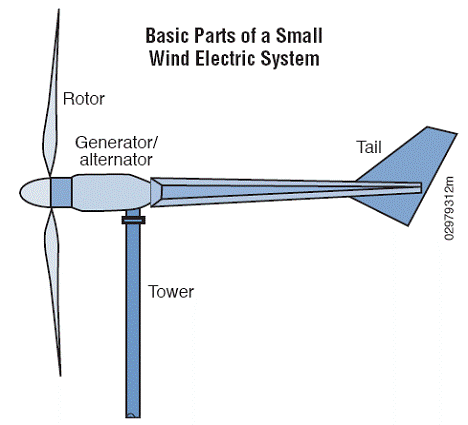Small Wind
Wind is created by the unequal heating of the Earth's surface by the sun. Wind turbines convert the wind energy into mechanical power that runs a generator to produce clean electricity. Today's turbines are versatile modular sources of electricity. Their blades are aerodynamically designed to capture the maximum energy from the wind. The wind turns the blades, which spin a shaft connected to a generator that makes electricity.

Source: U.S. Department of Energy
Wind turbines for a residential application typically range in electrical output capacity from 500 watts up to 10 kilowatts. In general there are two types of small wind systems: stand-alone units and grid-connected.
• Stand-alone systems
Small wind turbines are in use to generate electricity for charging batteries to run small electrical applications. There is need for this way of power generation for example in outlying locations where it is not economically sensible or physically possible to connect to the distribution grid, such as rural farms. Typical applications are electric fencing, small electric pumps, lighting or other small electronic systems needed, including security systems.
• Grid-connected systems
The output of a small wind turbine can be directly connected to the existing grid. This type of system can be used both for individual wind turbines and for wind farms exporting electricity to the electricity network. The energy generated by the homeowner's turbine can be used to reduce the need to buy energy from the local utility. The value of avoided electricity purchases is generally significantly higher than the value that can be obtained from exporting power to the grid. The interconnection with the distribution grid has to meet a high technical standard and therefore the cost of incorporating power import and export metering and approved electrical protection equipment can be high. For small wind turbines, the cost of grid connection can be a substantial part of the total project cost.
Small wind systems contain the following parts:
• Wind turbines
The rotors consist of two or three blades that are designed to capture the maximum energy from the wind. When the blades are turned by the wind, they spin a shaft connected to a generator that produces electrical energy. Small turbines are usually made with few moving parts and are designed robustly for deployment in areas where consistent maintenance is difficult and expensive.
• Tower
Turbines are mounted on towers, a mainframe that supports the rotor, a generator, and a tail which keeps the blades facing the wind. For small home systems, small towers around 4 to 6 meters can be used to assist in maintenance and transportability. For larger power systems, such as for schools on rural communities, the minimum tower height should be around 18m.
• Charge controller
The charge controller controls the charging of the battery by the wind turbine.
Additionally to the tower and turbine, a foundation usually made of reinforced concrete is needed. Furthermore, a wire run has to be installed, to conduct electricity from the generator to the electronics as well as a safety switch, which allows the electrical output to be isolated from the electronics.
Since the system does not provide constantly generated power, a battery can store the extra power which is generated at peak times. That power can be used in times of calm or low wind. Most household appliances use AC. Therefore, inverters are usually added to the system to convert DC into AC.
|